A Report on Leadership, Management, and Operations at Ford Motors
VerifiedAdded on 2020/09/03
|11
|3305
|37
Report
AI Summary
This report provides a comprehensive analysis of leadership, management, and operational strategies at Ford Motors. It begins by comparing the roles and characteristics of managers and leaders, emphasizing the significance of vision, change management, and identifying employee strengths. The report then explores the roles of leaders and managers in various situational contexts, including decision-making and risk-taking, highlighting the impact of Henry Ford's leadership. It delves into leadership models and theories, such as situational leadership and contingency approaches, and examines Ford's operational management approaches, specifically six sigma and lean manufacturing. The report underscores the importance of operational management in achieving organizational goals, along with factors influencing operational decisions at Ford, providing a detailed overview of the company's management practices.

Management and Operations
Paraphrase This Document
Need a fresh take? Get an instant paraphrase of this document with our AI Paraphraser
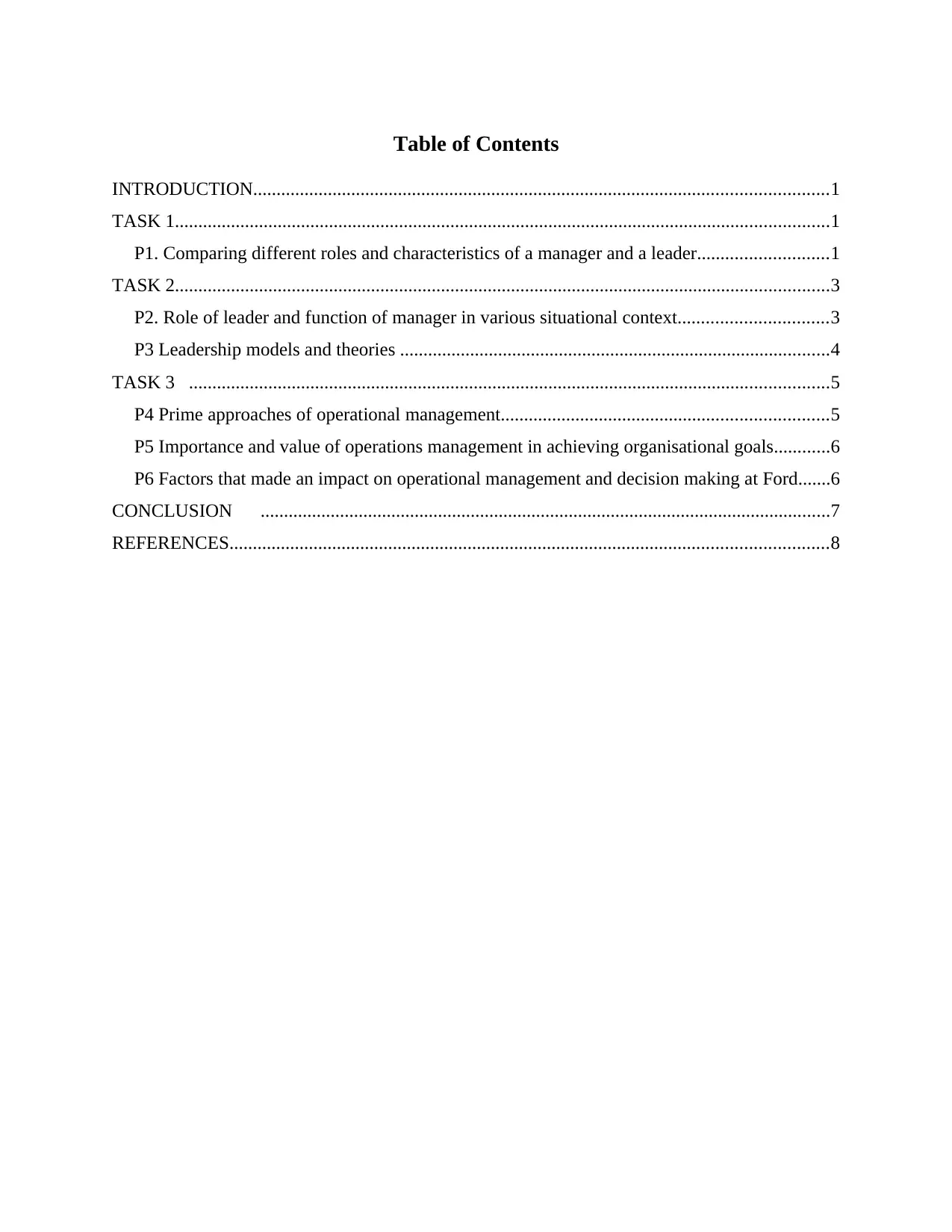
Table of Contents
INTRODUCTION...........................................................................................................................1
TASK 1............................................................................................................................................1
P1. Comparing different roles and characteristics of a manager and a leader............................1
TASK 2............................................................................................................................................3
P2. Role of leader and function of manager in various situational context................................3
P3 Leadership models and theories ............................................................................................4
TASK 3 .........................................................................................................................................5
P4 Prime approaches of operational management......................................................................5
P5 Importance and value of operations management in achieving organisational goals............6
P6 Factors that made an impact on operational management and decision making at Ford.......6
CONCLUSION ..........................................................................................................................7
REFERENCES................................................................................................................................8
INTRODUCTION...........................................................................................................................1
TASK 1............................................................................................................................................1
P1. Comparing different roles and characteristics of a manager and a leader............................1
TASK 2............................................................................................................................................3
P2. Role of leader and function of manager in various situational context................................3
P3 Leadership models and theories ............................................................................................4
TASK 3 .........................................................................................................................................5
P4 Prime approaches of operational management......................................................................5
P5 Importance and value of operations management in achieving organisational goals............6
P6 Factors that made an impact on operational management and decision making at Ford.......6
CONCLUSION ..........................................................................................................................7
REFERENCES................................................................................................................................8

⊘ This is a preview!⊘
Do you want full access?
Subscribe today to unlock all pages.

Trusted by 1+ million students worldwide
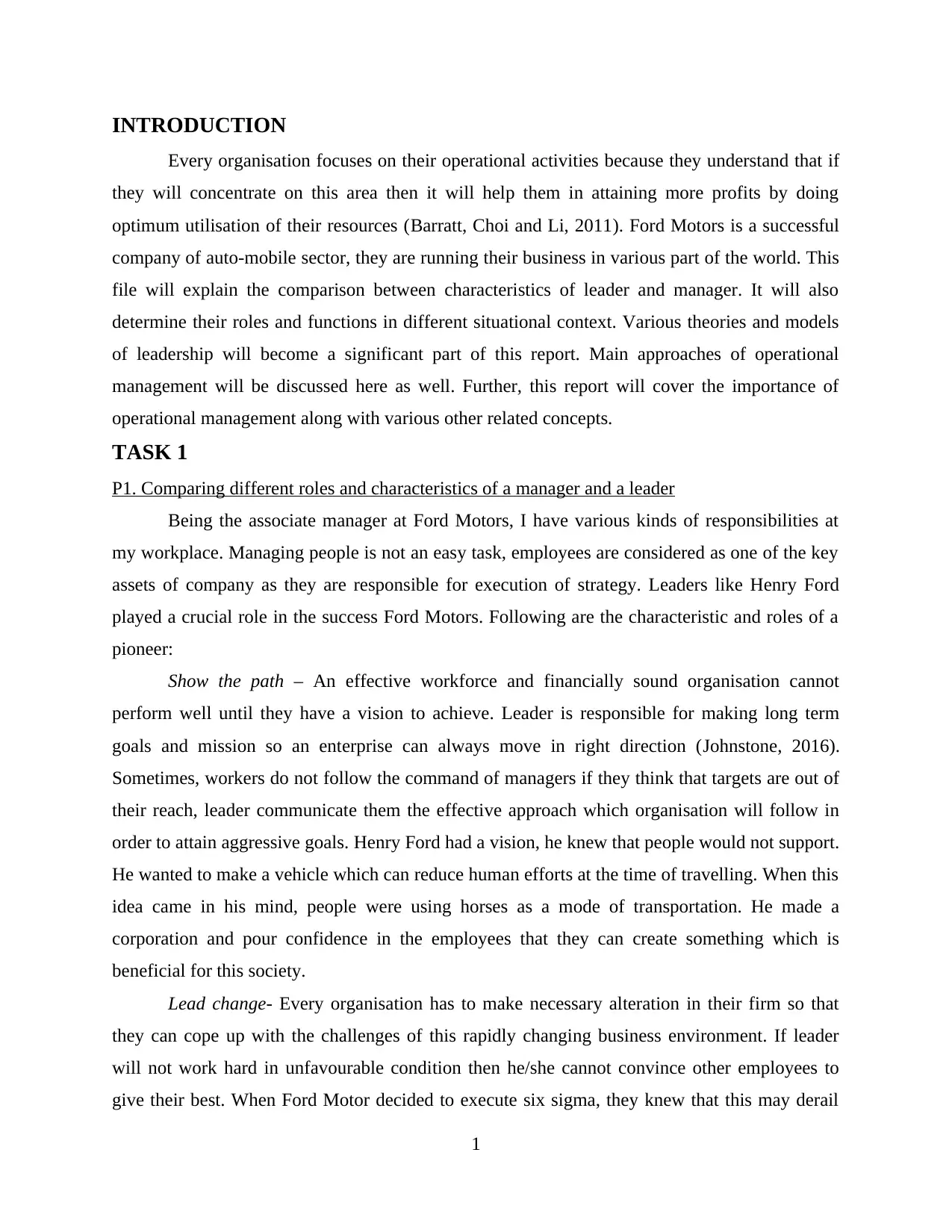
INTRODUCTION
Every organisation focuses on their operational activities because they understand that if
they will concentrate on this area then it will help them in attaining more profits by doing
optimum utilisation of their resources (Barratt, Choi and Li, 2011). Ford Motors is a successful
company of auto-mobile sector, they are running their business in various part of the world. This
file will explain the comparison between characteristics of leader and manager. It will also
determine their roles and functions in different situational context. Various theories and models
of leadership will become a significant part of this report. Main approaches of operational
management will be discussed here as well. Further, this report will cover the importance of
operational management along with various other related concepts.
TASK 1
P1. Comparing different roles and characteristics of a manager and a leader
Being the associate manager at Ford Motors, I have various kinds of responsibilities at
my workplace. Managing people is not an easy task, employees are considered as one of the key
assets of company as they are responsible for execution of strategy. Leaders like Henry Ford
played a crucial role in the success Ford Motors. Following are the characteristic and roles of a
pioneer:
Show the path – An effective workforce and financially sound organisation cannot
perform well until they have a vision to achieve. Leader is responsible for making long term
goals and mission so an enterprise can always move in right direction (Johnstone, 2016).
Sometimes, workers do not follow the command of managers if they think that targets are out of
their reach, leader communicate them the effective approach which organisation will follow in
order to attain aggressive goals. Henry Ford had a vision, he knew that people would not support.
He wanted to make a vehicle which can reduce human efforts at the time of travelling. When this
idea came in his mind, people were using horses as a mode of transportation. He made a
corporation and pour confidence in the employees that they can create something which is
beneficial for this society.
Lead change- Every organisation has to make necessary alteration in their firm so that
they can cope up with the challenges of this rapidly changing business environment. If leader
will not work hard in unfavourable condition then he/she cannot convince other employees to
give their best. When Ford Motor decided to execute six sigma, they knew that this may derail
1
Every organisation focuses on their operational activities because they understand that if
they will concentrate on this area then it will help them in attaining more profits by doing
optimum utilisation of their resources (Barratt, Choi and Li, 2011). Ford Motors is a successful
company of auto-mobile sector, they are running their business in various part of the world. This
file will explain the comparison between characteristics of leader and manager. It will also
determine their roles and functions in different situational context. Various theories and models
of leadership will become a significant part of this report. Main approaches of operational
management will be discussed here as well. Further, this report will cover the importance of
operational management along with various other related concepts.
TASK 1
P1. Comparing different roles and characteristics of a manager and a leader
Being the associate manager at Ford Motors, I have various kinds of responsibilities at
my workplace. Managing people is not an easy task, employees are considered as one of the key
assets of company as they are responsible for execution of strategy. Leaders like Henry Ford
played a crucial role in the success Ford Motors. Following are the characteristic and roles of a
pioneer:
Show the path – An effective workforce and financially sound organisation cannot
perform well until they have a vision to achieve. Leader is responsible for making long term
goals and mission so an enterprise can always move in right direction (Johnstone, 2016).
Sometimes, workers do not follow the command of managers if they think that targets are out of
their reach, leader communicate them the effective approach which organisation will follow in
order to attain aggressive goals. Henry Ford had a vision, he knew that people would not support.
He wanted to make a vehicle which can reduce human efforts at the time of travelling. When this
idea came in his mind, people were using horses as a mode of transportation. He made a
corporation and pour confidence in the employees that they can create something which is
beneficial for this society.
Lead change- Every organisation has to make necessary alteration in their firm so that
they can cope up with the challenges of this rapidly changing business environment. If leader
will not work hard in unfavourable condition then he/she cannot convince other employees to
give their best. When Ford Motor decided to execute six sigma, they knew that this may derail
1
Paraphrase This Document
Need a fresh take? Get an instant paraphrase of this document with our AI Paraphraser

the whole operations of company. Many senior managers were spending most of their time at the
workplace as they had to perform their normal duties and at the same time they have to spend
extra time of training session. Henry Ford also enhanced his working hours so that workers
would not think that their leader do not ''walk his talk''. He also learnt some of the new
techniques of manufacturing and this step played a significant role in increasing the morale of
workers.
Determine qualities in a person – This can be considered as one of the most important
characteristics of a leader. He/she has an ability to find the strengths and weaknesses that are
present in an employee (Shuxin, 2011). If they understand the skills of a worker then they can
easily give them a task which personnel can easily accomplish. Henry Ford was capable of
reading the mind of his subordinates.
Role and characteristic of manager
Execution of plans – Top level management make strategies but they seek support from
the side of employees for implementation of tactics. It is the responsibility of manager to execute
the thought of board of directors. They have to manage the resources in such a way that
organisation can attain their goals in an effective manner. Senior managers of Ford Motors
played a significant role at the time of execution of sixth sigma. They work as a bridge between
employees who are working at ground and top level management of the firm.
Monitoring – Managing people may not have a vision but they monitor various strategies
which have no contribution in the long term goals of organisation. It is the role of manager to
stop employees for committing a mistake at workplace (Liker and Morgan, 2011). When workers
do not have essential experience, they commit different types of blunders. Ford Motors is known
for introducing various new production procedures, when they adopted automation head of
different departments monitored performance of every single employee.
Resolve conflict – Manager have the ability to solve disputes between two workers, or
management and personnel. Negotiation and communication skills are significant part of their
characteristics.
Difference between manager and leader
Leader Manager
They main focus is on future activities. Their main concentration is on present business
2
workplace as they had to perform their normal duties and at the same time they have to spend
extra time of training session. Henry Ford also enhanced his working hours so that workers
would not think that their leader do not ''walk his talk''. He also learnt some of the new
techniques of manufacturing and this step played a significant role in increasing the morale of
workers.
Determine qualities in a person – This can be considered as one of the most important
characteristics of a leader. He/she has an ability to find the strengths and weaknesses that are
present in an employee (Shuxin, 2011). If they understand the skills of a worker then they can
easily give them a task which personnel can easily accomplish. Henry Ford was capable of
reading the mind of his subordinates.
Role and characteristic of manager
Execution of plans – Top level management make strategies but they seek support from
the side of employees for implementation of tactics. It is the responsibility of manager to execute
the thought of board of directors. They have to manage the resources in such a way that
organisation can attain their goals in an effective manner. Senior managers of Ford Motors
played a significant role at the time of execution of sixth sigma. They work as a bridge between
employees who are working at ground and top level management of the firm.
Monitoring – Managing people may not have a vision but they monitor various strategies
which have no contribution in the long term goals of organisation. It is the role of manager to
stop employees for committing a mistake at workplace (Liker and Morgan, 2011). When workers
do not have essential experience, they commit different types of blunders. Ford Motors is known
for introducing various new production procedures, when they adopted automation head of
different departments monitored performance of every single employee.
Resolve conflict – Manager have the ability to solve disputes between two workers, or
management and personnel. Negotiation and communication skills are significant part of their
characteristics.
Difference between manager and leader
Leader Manager
They main focus is on future activities. Their main concentration is on present business
2

activities.
They are responsible for inspiring workers. It is the responsibility of manager to perform all
tasks relating to administration.
Their presence is important when company
needs to deal with various kind of changes.
Their main work is to reduce the complexity in
business operations.
They generally set long term goals. They make tactics for attaining various
objectives.
TASK 2
P2. Role of leader and function of manager in various situational context
Ford Motors had great leaders in their organisation but one cannot ignore the contribution
of managers (Bhasin, 2011). Both are dependent on each other and if they will work together
then an enterprise can easily achieve their objectives. Following are some of the roles and
functions of manager and leader in different conditions:
Decision making
Leader's Role – All the organisations have to go through various kinds of changes in order to
remain in business for long period of time. The decision of implementing six sigma was very
important for Ford Motors, they wanted to increase level of customer satisfaction and this work
can only be done by raising their living standards. Most of the employees of this company were
not interested in getting additional training because it would have increased their working hours.
Normally, managers are responsible for resolving these kinds of conflicts but they had their own
queries relating to six sigma. The role of leader is significant in this scenario, they motivate
workers to expand their limits. They inspire them to learn new things because it will be
beneficial for both sides. They are basically responsible for changing perception of employees.
Manager's function – Manager generally make small decision, they may give their advice to the
leaders but he does not make final call. When Ford Motors decided to execute six sigma, their
managers did hard work by spending extra time of training procedures. Doing two task in a
single time is not an easy task but when they gave their best, their subordinates also get
motivation to raise their limits and join hard training session (Zhang and Chen, 2014). Role of
3
They are responsible for inspiring workers. It is the responsibility of manager to perform all
tasks relating to administration.
Their presence is important when company
needs to deal with various kind of changes.
Their main work is to reduce the complexity in
business operations.
They generally set long term goals. They make tactics for attaining various
objectives.
TASK 2
P2. Role of leader and function of manager in various situational context
Ford Motors had great leaders in their organisation but one cannot ignore the contribution
of managers (Bhasin, 2011). Both are dependent on each other and if they will work together
then an enterprise can easily achieve their objectives. Following are some of the roles and
functions of manager and leader in different conditions:
Decision making
Leader's Role – All the organisations have to go through various kinds of changes in order to
remain in business for long period of time. The decision of implementing six sigma was very
important for Ford Motors, they wanted to increase level of customer satisfaction and this work
can only be done by raising their living standards. Most of the employees of this company were
not interested in getting additional training because it would have increased their working hours.
Normally, managers are responsible for resolving these kinds of conflicts but they had their own
queries relating to six sigma. The role of leader is significant in this scenario, they motivate
workers to expand their limits. They inspire them to learn new things because it will be
beneficial for both sides. They are basically responsible for changing perception of employees.
Manager's function – Manager generally make small decision, they may give their advice to the
leaders but he does not make final call. When Ford Motors decided to execute six sigma, their
managers did hard work by spending extra time of training procedures. Doing two task in a
single time is not an easy task but when they gave their best, their subordinates also get
motivation to raise their limits and join hard training session (Zhang and Chen, 2014). Role of
3
⊘ This is a preview!⊘
Do you want full access?
Subscribe today to unlock all pages.

Trusted by 1+ million students worldwide
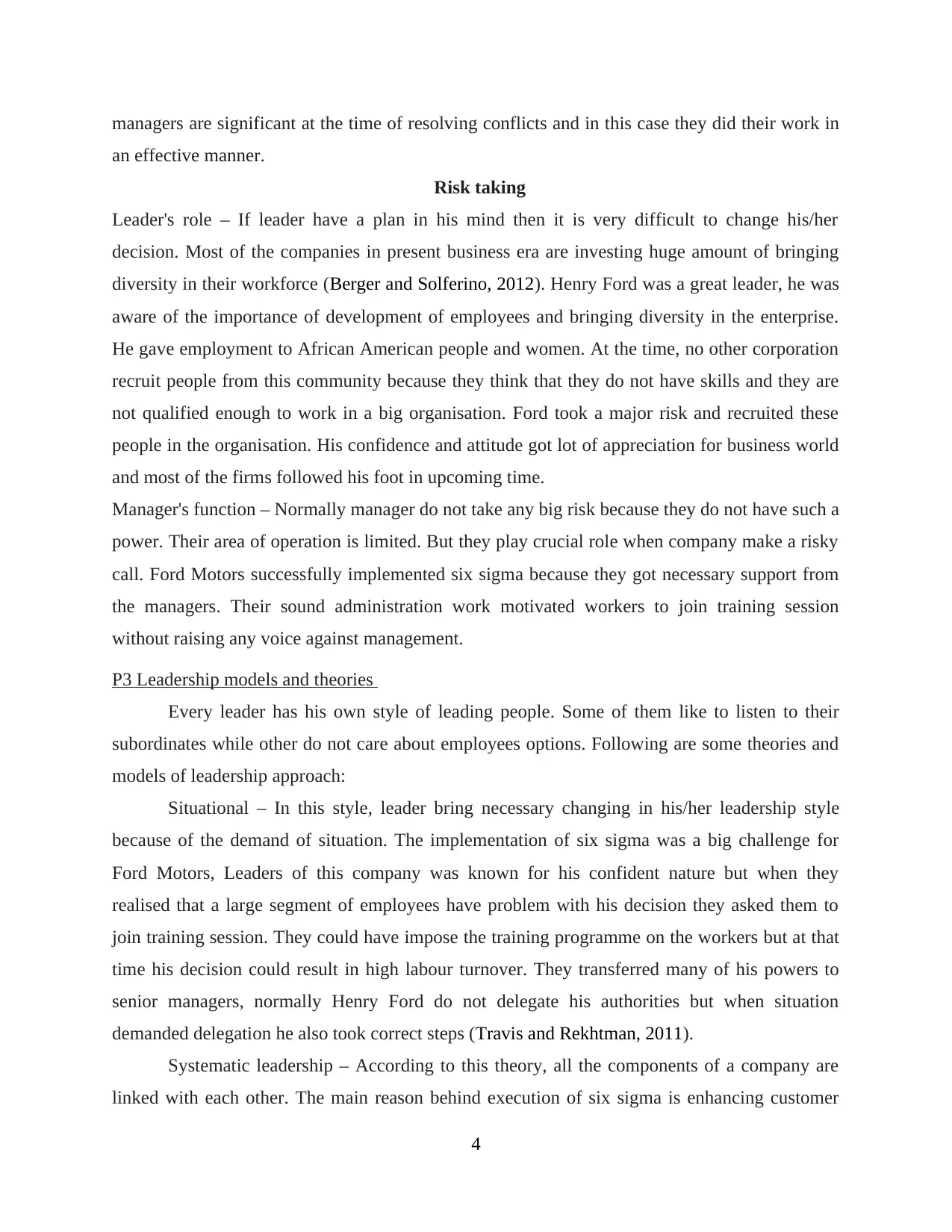
managers are significant at the time of resolving conflicts and in this case they did their work in
an effective manner.
Risk taking
Leader's role – If leader have a plan in his mind then it is very difficult to change his/her
decision. Most of the companies in present business era are investing huge amount of bringing
diversity in their workforce (Berger and Solferino, 2012). Henry Ford was a great leader, he was
aware of the importance of development of employees and bringing diversity in the enterprise.
He gave employment to African American people and women. At the time, no other corporation
recruit people from this community because they think that they do not have skills and they are
not qualified enough to work in a big organisation. Ford took a major risk and recruited these
people in the organisation. His confidence and attitude got lot of appreciation for business world
and most of the firms followed his foot in upcoming time.
Manager's function – Normally manager do not take any big risk because they do not have such a
power. Their area of operation is limited. But they play crucial role when company make a risky
call. Ford Motors successfully implemented six sigma because they got necessary support from
the managers. Their sound administration work motivated workers to join training session
without raising any voice against management.
P3 Leadership models and theories
Every leader has his own style of leading people. Some of them like to listen to their
subordinates while other do not care about employees options. Following are some theories and
models of leadership approach:
Situational – In this style, leader bring necessary changing in his/her leadership style
because of the demand of situation. The implementation of six sigma was a big challenge for
Ford Motors, Leaders of this company was known for his confident nature but when they
realised that a large segment of employees have problem with his decision they asked them to
join training session. They could have impose the training programme on the workers but at that
time his decision could result in high labour turnover. They transferred many of his powers to
senior managers, normally Henry Ford do not delegate his authorities but when situation
demanded delegation he also took correct steps (Travis and Rekhtman, 2011).
Systematic leadership – According to this theory, all the components of a company are
linked with each other. The main reason behind execution of six sigma is enhancing customer
4
an effective manner.
Risk taking
Leader's role – If leader have a plan in his mind then it is very difficult to change his/her
decision. Most of the companies in present business era are investing huge amount of bringing
diversity in their workforce (Berger and Solferino, 2012). Henry Ford was a great leader, he was
aware of the importance of development of employees and bringing diversity in the enterprise.
He gave employment to African American people and women. At the time, no other corporation
recruit people from this community because they think that they do not have skills and they are
not qualified enough to work in a big organisation. Ford took a major risk and recruited these
people in the organisation. His confidence and attitude got lot of appreciation for business world
and most of the firms followed his foot in upcoming time.
Manager's function – Normally manager do not take any big risk because they do not have such a
power. Their area of operation is limited. But they play crucial role when company make a risky
call. Ford Motors successfully implemented six sigma because they got necessary support from
the managers. Their sound administration work motivated workers to join training session
without raising any voice against management.
P3 Leadership models and theories
Every leader has his own style of leading people. Some of them like to listen to their
subordinates while other do not care about employees options. Following are some theories and
models of leadership approach:
Situational – In this style, leader bring necessary changing in his/her leadership style
because of the demand of situation. The implementation of six sigma was a big challenge for
Ford Motors, Leaders of this company was known for his confident nature but when they
realised that a large segment of employees have problem with his decision they asked them to
join training session. They could have impose the training programme on the workers but at that
time his decision could result in high labour turnover. They transferred many of his powers to
senior managers, normally Henry Ford do not delegate his authorities but when situation
demanded delegation he also took correct steps (Travis and Rekhtman, 2011).
Systematic leadership – According to this theory, all the components of a company are
linked with each other. The main reason behind execution of six sigma is enhancing customer
4
Paraphrase This Document
Need a fresh take? Get an instant paraphrase of this document with our AI Paraphraser
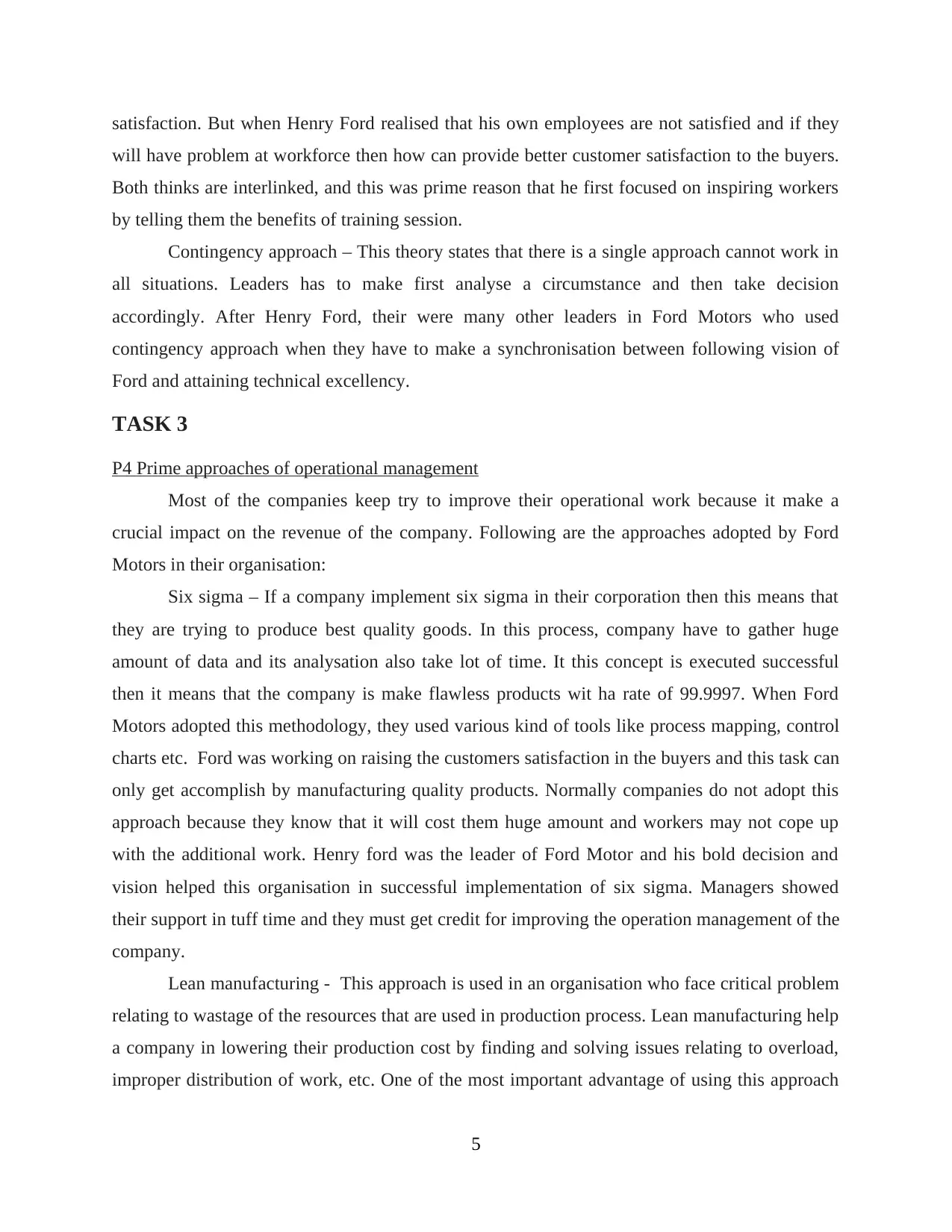
satisfaction. But when Henry Ford realised that his own employees are not satisfied and if they
will have problem at workforce then how can provide better customer satisfaction to the buyers.
Both thinks are interlinked, and this was prime reason that he first focused on inspiring workers
by telling them the benefits of training session.
Contingency approach – This theory states that there is a single approach cannot work in
all situations. Leaders has to make first analyse a circumstance and then take decision
accordingly. After Henry Ford, their were many other leaders in Ford Motors who used
contingency approach when they have to make a synchronisation between following vision of
Ford and attaining technical excellency.
TASK 3
P4 Prime approaches of operational management
Most of the companies keep try to improve their operational work because it make a
crucial impact on the revenue of the company. Following are the approaches adopted by Ford
Motors in their organisation:
Six sigma – If a company implement six sigma in their corporation then this means that
they are trying to produce best quality goods. In this process, company have to gather huge
amount of data and its analysation also take lot of time. It this concept is executed successful
then it means that the company is make flawless products wit ha rate of 99.9997. When Ford
Motors adopted this methodology, they used various kind of tools like process mapping, control
charts etc. Ford was working on raising the customers satisfaction in the buyers and this task can
only get accomplish by manufacturing quality products. Normally companies do not adopt this
approach because they know that it will cost them huge amount and workers may not cope up
with the additional work. Henry ford was the leader of Ford Motor and his bold decision and
vision helped this organisation in successful implementation of six sigma. Managers showed
their support in tuff time and they must get credit for improving the operation management of the
company.
Lean manufacturing - This approach is used in an organisation who face critical problem
relating to wastage of the resources that are used in production process. Lean manufacturing help
a company in lowering their production cost by finding and solving issues relating to overload,
improper distribution of work, etc. One of the most important advantage of using this approach
5
will have problem at workforce then how can provide better customer satisfaction to the buyers.
Both thinks are interlinked, and this was prime reason that he first focused on inspiring workers
by telling them the benefits of training session.
Contingency approach – This theory states that there is a single approach cannot work in
all situations. Leaders has to make first analyse a circumstance and then take decision
accordingly. After Henry Ford, their were many other leaders in Ford Motors who used
contingency approach when they have to make a synchronisation between following vision of
Ford and attaining technical excellency.
TASK 3
P4 Prime approaches of operational management
Most of the companies keep try to improve their operational work because it make a
crucial impact on the revenue of the company. Following are the approaches adopted by Ford
Motors in their organisation:
Six sigma – If a company implement six sigma in their corporation then this means that
they are trying to produce best quality goods. In this process, company have to gather huge
amount of data and its analysation also take lot of time. It this concept is executed successful
then it means that the company is make flawless products wit ha rate of 99.9997. When Ford
Motors adopted this methodology, they used various kind of tools like process mapping, control
charts etc. Ford was working on raising the customers satisfaction in the buyers and this task can
only get accomplish by manufacturing quality products. Normally companies do not adopt this
approach because they know that it will cost them huge amount and workers may not cope up
with the additional work. Henry ford was the leader of Ford Motor and his bold decision and
vision helped this organisation in successful implementation of six sigma. Managers showed
their support in tuff time and they must get credit for improving the operation management of the
company.
Lean manufacturing - This approach is used in an organisation who face critical problem
relating to wastage of the resources that are used in production process. Lean manufacturing help
a company in lowering their production cost by finding and solving issues relating to overload,
improper distribution of work, etc. One of the most important advantage of using this approach
5
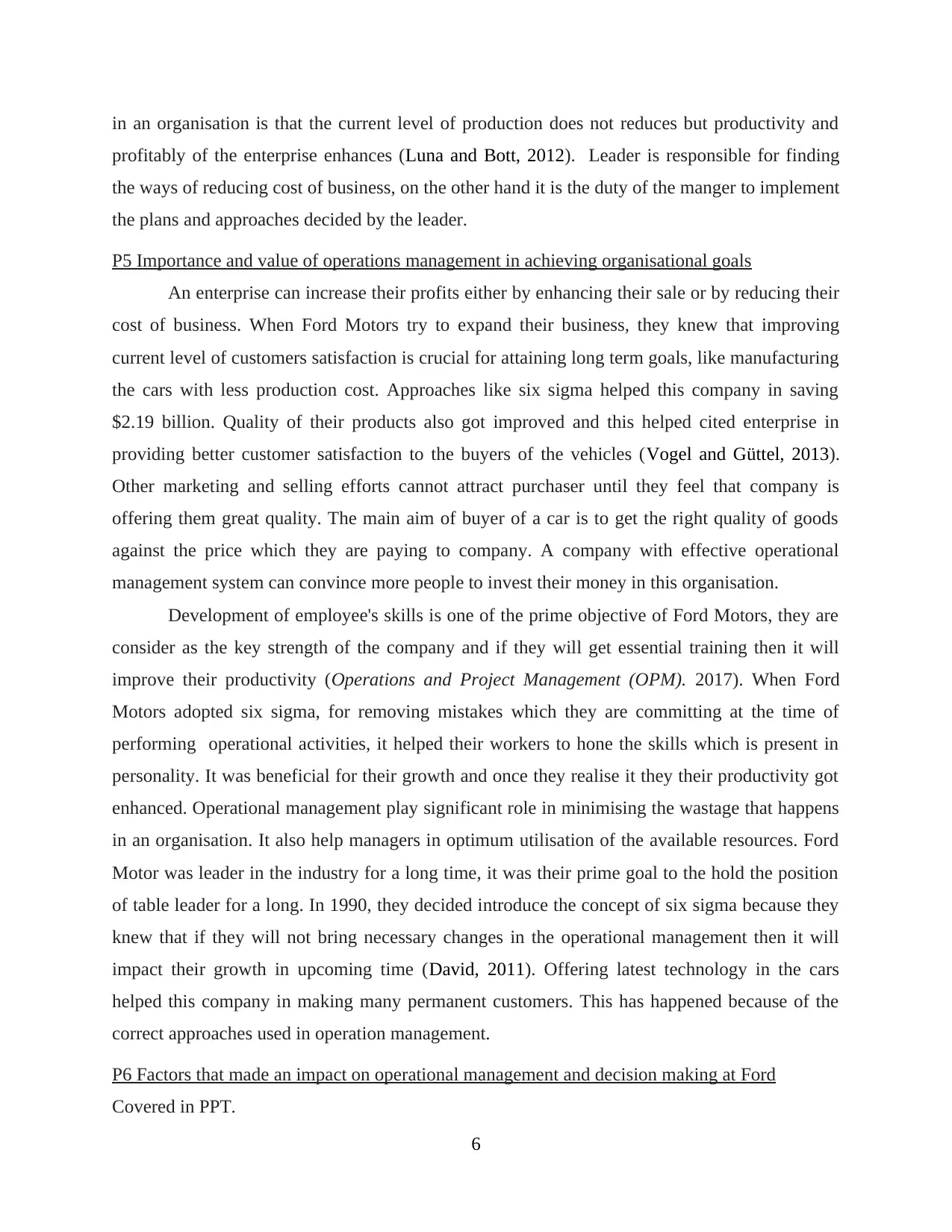
in an organisation is that the current level of production does not reduces but productivity and
profitably of the enterprise enhances (Luna and Bott, 2012). Leader is responsible for finding
the ways of reducing cost of business, on the other hand it is the duty of the manger to implement
the plans and approaches decided by the leader.
P5 Importance and value of operations management in achieving organisational goals
An enterprise can increase their profits either by enhancing their sale or by reducing their
cost of business. When Ford Motors try to expand their business, they knew that improving
current level of customers satisfaction is crucial for attaining long term goals, like manufacturing
the cars with less production cost. Approaches like six sigma helped this company in saving
$2.19 billion. Quality of their products also got improved and this helped cited enterprise in
providing better customer satisfaction to the buyers of the vehicles (Vogel and Güttel, 2013).
Other marketing and selling efforts cannot attract purchaser until they feel that company is
offering them great quality. The main aim of buyer of a car is to get the right quality of goods
against the price which they are paying to company. A company with effective operational
management system can convince more people to invest their money in this organisation.
Development of employee's skills is one of the prime objective of Ford Motors, they are
consider as the key strength of the company and if they will get essential training then it will
improve their productivity (Operations and Project Management (OPM). 2017). When Ford
Motors adopted six sigma, for removing mistakes which they are committing at the time of
performing operational activities, it helped their workers to hone the skills which is present in
personality. It was beneficial for their growth and once they realise it they their productivity got
enhanced. Operational management play significant role in minimising the wastage that happens
in an organisation. It also help managers in optimum utilisation of the available resources. Ford
Motor was leader in the industry for a long time, it was their prime goal to the hold the position
of table leader for a long. In 1990, they decided introduce the concept of six sigma because they
knew that if they will not bring necessary changes in the operational management then it will
impact their growth in upcoming time (David, 2011). Offering latest technology in the cars
helped this company in making many permanent customers. This has happened because of the
correct approaches used in operation management.
P6 Factors that made an impact on operational management and decision making at Ford
Covered in PPT.
6
profitably of the enterprise enhances (Luna and Bott, 2012). Leader is responsible for finding
the ways of reducing cost of business, on the other hand it is the duty of the manger to implement
the plans and approaches decided by the leader.
P5 Importance and value of operations management in achieving organisational goals
An enterprise can increase their profits either by enhancing their sale or by reducing their
cost of business. When Ford Motors try to expand their business, they knew that improving
current level of customers satisfaction is crucial for attaining long term goals, like manufacturing
the cars with less production cost. Approaches like six sigma helped this company in saving
$2.19 billion. Quality of their products also got improved and this helped cited enterprise in
providing better customer satisfaction to the buyers of the vehicles (Vogel and Güttel, 2013).
Other marketing and selling efforts cannot attract purchaser until they feel that company is
offering them great quality. The main aim of buyer of a car is to get the right quality of goods
against the price which they are paying to company. A company with effective operational
management system can convince more people to invest their money in this organisation.
Development of employee's skills is one of the prime objective of Ford Motors, they are
consider as the key strength of the company and if they will get essential training then it will
improve their productivity (Operations and Project Management (OPM). 2017). When Ford
Motors adopted six sigma, for removing mistakes which they are committing at the time of
performing operational activities, it helped their workers to hone the skills which is present in
personality. It was beneficial for their growth and once they realise it they their productivity got
enhanced. Operational management play significant role in minimising the wastage that happens
in an organisation. It also help managers in optimum utilisation of the available resources. Ford
Motor was leader in the industry for a long time, it was their prime goal to the hold the position
of table leader for a long. In 1990, they decided introduce the concept of six sigma because they
knew that if they will not bring necessary changes in the operational management then it will
impact their growth in upcoming time (David, 2011). Offering latest technology in the cars
helped this company in making many permanent customers. This has happened because of the
correct approaches used in operation management.
P6 Factors that made an impact on operational management and decision making at Ford
Covered in PPT.
6
⊘ This is a preview!⊘
Do you want full access?
Subscribe today to unlock all pages.

Trusted by 1+ million students worldwide
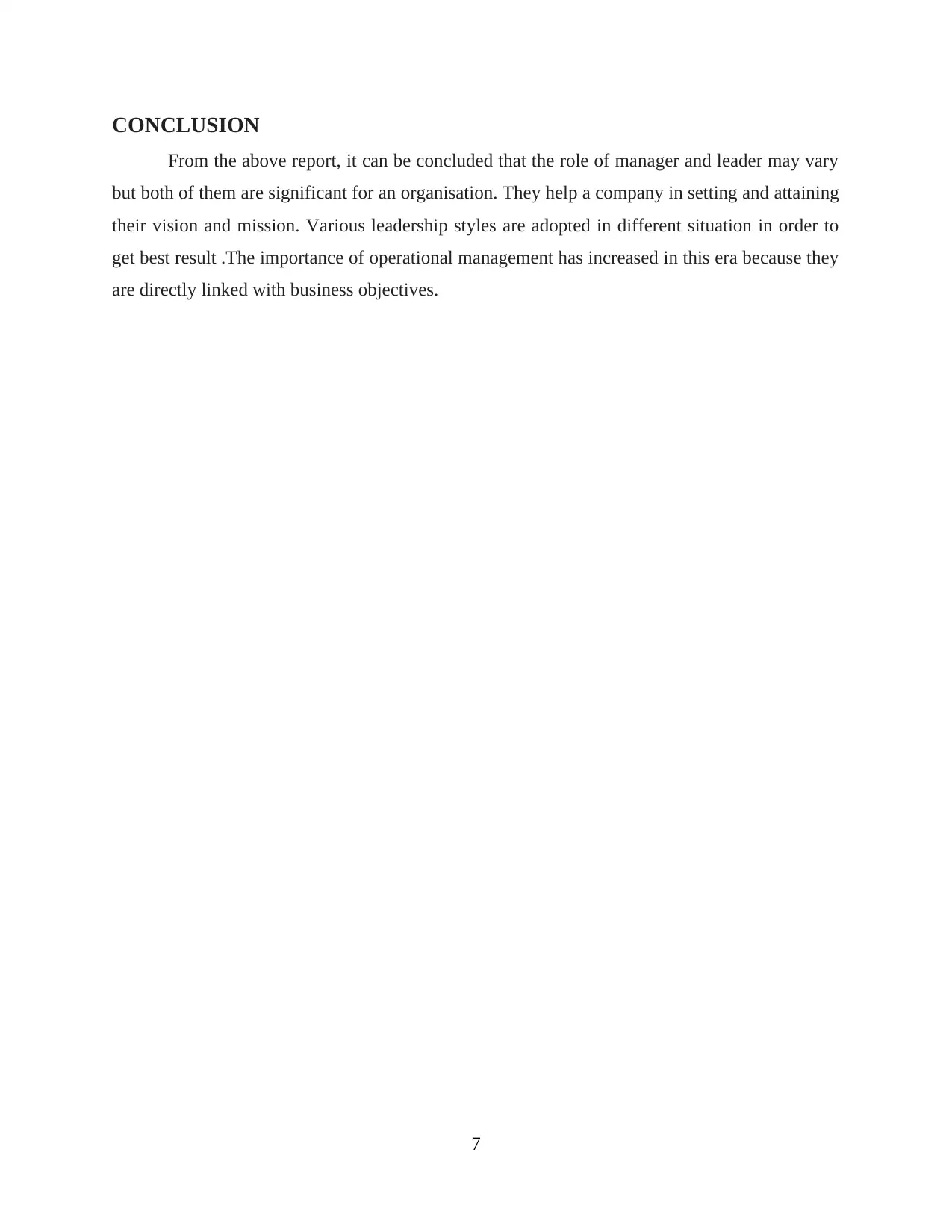
CONCLUSION
From the above report, it can be concluded that the role of manager and leader may vary
but both of them are significant for an organisation. They help a company in setting and attaining
their vision and mission. Various leadership styles are adopted in different situation in order to
get best result .The importance of operational management has increased in this era because they
are directly linked with business objectives.
7
From the above report, it can be concluded that the role of manager and leader may vary
but both of them are significant for an organisation. They help a company in setting and attaining
their vision and mission. Various leadership styles are adopted in different situation in order to
get best result .The importance of operational management has increased in this era because they
are directly linked with business objectives.
7
Paraphrase This Document
Need a fresh take? Get an instant paraphrase of this document with our AI Paraphraser
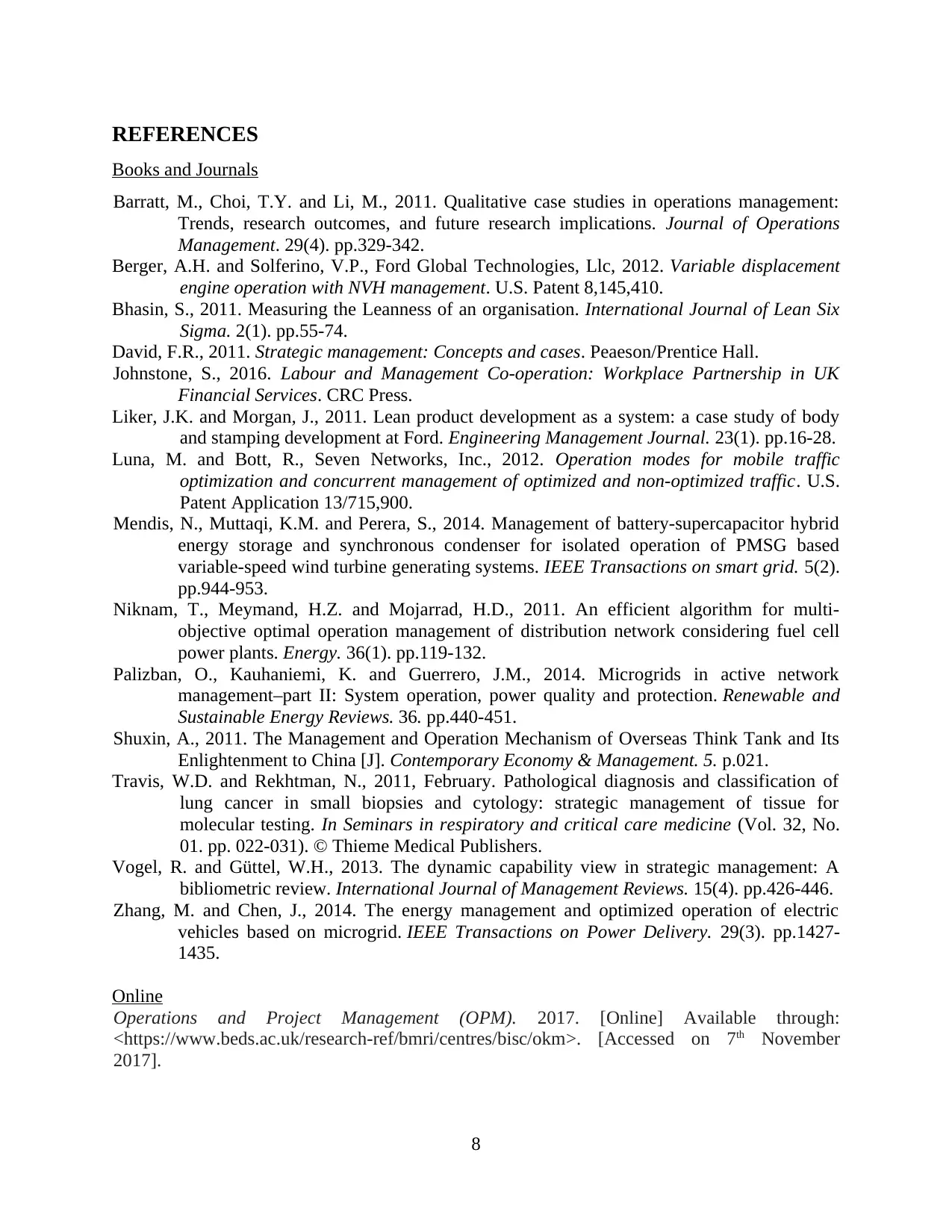
REFERENCES
Books and Journals
Barratt, M., Choi, T.Y. and Li, M., 2011. Qualitative case studies in operations management:
Trends, research outcomes, and future research implications. Journal of Operations
Management. 29(4). pp.329-342.
Berger, A.H. and Solferino, V.P., Ford Global Technologies, Llc, 2012. Variable displacement
engine operation with NVH management. U.S. Patent 8,145,410.
Bhasin, S., 2011. Measuring the Leanness of an organisation. International Journal of Lean Six
Sigma. 2(1). pp.55-74.
David, F.R., 2011. Strategic management: Concepts and cases. Peaeson/Prentice Hall.
Johnstone, S., 2016. Labour and Management Co-operation: Workplace Partnership in UK
Financial Services. CRC Press.
Liker, J.K. and Morgan, J., 2011. Lean product development as a system: a case study of body
and stamping development at Ford. Engineering Management Journal. 23(1). pp.16-28.
Luna, M. and Bott, R., Seven Networks, Inc., 2012. Operation modes for mobile traffic
optimization and concurrent management of optimized and non-optimized traffic. U.S.
Patent Application 13/715,900.
Mendis, N., Muttaqi, K.M. and Perera, S., 2014. Management of battery-supercapacitor hybrid
energy storage and synchronous condenser for isolated operation of PMSG based
variable-speed wind turbine generating systems. IEEE Transactions on smart grid. 5(2).
pp.944-953.
Niknam, T., Meymand, H.Z. and Mojarrad, H.D., 2011. An efficient algorithm for multi-
objective optimal operation management of distribution network considering fuel cell
power plants. Energy. 36(1). pp.119-132.
Palizban, O., Kauhaniemi, K. and Guerrero, J.M., 2014. Microgrids in active network
management–part II: System operation, power quality and protection. Renewable and
Sustainable Energy Reviews. 36. pp.440-451.
Shuxin, A., 2011. The Management and Operation Mechanism of Overseas Think Tank and Its
Enlightenment to China [J]. Contemporary Economy & Management. 5. p.021.
Travis, W.D. and Rekhtman, N., 2011, February. Pathological diagnosis and classification of
lung cancer in small biopsies and cytology: strategic management of tissue for
molecular testing. In Seminars in respiratory and critical care medicine (Vol. 32, No.
01. pp. 022-031). © Thieme Medical Publishers.
Vogel, R. and Güttel, W.H., 2013. The dynamic capability view in strategic management: A
bibliometric review. International Journal of Management Reviews. 15(4). pp.426-446.
Zhang, M. and Chen, J., 2014. The energy management and optimized operation of electric
vehicles based on microgrid. IEEE Transactions on Power Delivery. 29(3). pp.1427-
1435.
Online
Operations and Project Management (OPM). 2017. [Online] Available through:
<https://www.beds.ac.uk/research-ref/bmri/centres/bisc/okm>. [Accessed on 7th November
2017].
8
Books and Journals
Barratt, M., Choi, T.Y. and Li, M., 2011. Qualitative case studies in operations management:
Trends, research outcomes, and future research implications. Journal of Operations
Management. 29(4). pp.329-342.
Berger, A.H. and Solferino, V.P., Ford Global Technologies, Llc, 2012. Variable displacement
engine operation with NVH management. U.S. Patent 8,145,410.
Bhasin, S., 2011. Measuring the Leanness of an organisation. International Journal of Lean Six
Sigma. 2(1). pp.55-74.
David, F.R., 2011. Strategic management: Concepts and cases. Peaeson/Prentice Hall.
Johnstone, S., 2016. Labour and Management Co-operation: Workplace Partnership in UK
Financial Services. CRC Press.
Liker, J.K. and Morgan, J., 2011. Lean product development as a system: a case study of body
and stamping development at Ford. Engineering Management Journal. 23(1). pp.16-28.
Luna, M. and Bott, R., Seven Networks, Inc., 2012. Operation modes for mobile traffic
optimization and concurrent management of optimized and non-optimized traffic. U.S.
Patent Application 13/715,900.
Mendis, N., Muttaqi, K.M. and Perera, S., 2014. Management of battery-supercapacitor hybrid
energy storage and synchronous condenser for isolated operation of PMSG based
variable-speed wind turbine generating systems. IEEE Transactions on smart grid. 5(2).
pp.944-953.
Niknam, T., Meymand, H.Z. and Mojarrad, H.D., 2011. An efficient algorithm for multi-
objective optimal operation management of distribution network considering fuel cell
power plants. Energy. 36(1). pp.119-132.
Palizban, O., Kauhaniemi, K. and Guerrero, J.M., 2014. Microgrids in active network
management–part II: System operation, power quality and protection. Renewable and
Sustainable Energy Reviews. 36. pp.440-451.
Shuxin, A., 2011. The Management and Operation Mechanism of Overseas Think Tank and Its
Enlightenment to China [J]. Contemporary Economy & Management. 5. p.021.
Travis, W.D. and Rekhtman, N., 2011, February. Pathological diagnosis and classification of
lung cancer in small biopsies and cytology: strategic management of tissue for
molecular testing. In Seminars in respiratory and critical care medicine (Vol. 32, No.
01. pp. 022-031). © Thieme Medical Publishers.
Vogel, R. and Güttel, W.H., 2013. The dynamic capability view in strategic management: A
bibliometric review. International Journal of Management Reviews. 15(4). pp.426-446.
Zhang, M. and Chen, J., 2014. The energy management and optimized operation of electric
vehicles based on microgrid. IEEE Transactions on Power Delivery. 29(3). pp.1427-
1435.
Online
Operations and Project Management (OPM). 2017. [Online] Available through:
<https://www.beds.ac.uk/research-ref/bmri/centres/bisc/okm>. [Accessed on 7th November
2017].
8
1 out of 11
Related Documents
Your All-in-One AI-Powered Toolkit for Academic Success.
+13062052269
info@desklib.com
Available 24*7 on WhatsApp / Email
![[object Object]](/_next/static/media/star-bottom.7253800d.svg)
Unlock your academic potential
Copyright © 2020–2025 A2Z Services. All Rights Reserved. Developed and managed by ZUCOL.





